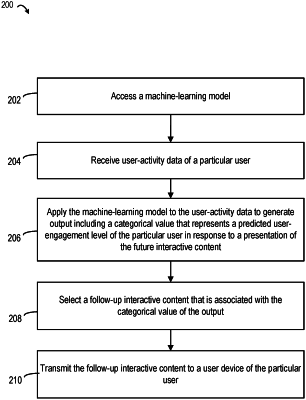| CPC G06N 20/00 (2019.01) [G06F 3/0484 (2013.01); H04L 67/535 (2022.05)] | 19 Claims |

|
1. A method comprising:
accessing, by a content provider system, a machine-learning model configured to predict user-engagement levels of users in response to presentation of future interactive content of a targeted campaign initiated by the content provider system, wherein the machine-learning model was trained using a training dataset including previous user-device actions performed by a plurality of users in response to previous interactive content associated with other campaigns, and wherein the machine-learning model was trained at least by:
identifying a time period within which the previous user-device actions were performed;
splitting the time period into a set of time windows; and
training, for a subset of time windows of the set of time windows, the machine-learning model using a subset of the training dataset corresponding to a time window of the subset of time windows, wherein the subset of the training dataset includes previous user-device actions performed by at least one of the plurality of users and identified as being performed within the time window, wherein a duration of the time window is adjustable based on user-device actions in a corresponding subset of training dataset during training, and wherein training the machine-learning model comprises creating a target label representing a known user-engagement level of a user associated with the subset of training dataset;
receiving, by the content provider system, user-activity data of a particular user, wherein the user-activity data includes one or more user-device actions performed by the particular user in response to an interactive content of the targeted campaign;
applying, by the content provider system, the machine-learning model to the user-activity data to generate an output including a categorical value that represents a predicted user-engagement level of the particular user at a particular future time point in response to a presentation of the future interactive content of the targeted campaign, wherein the particular future time point is defined by a preconfigured duration of time elapsed from a time when a particular user-device action is performed in response to the interactive content of the targeted campaign;
selecting, by the content provider system, a follow-up interactive content that is associated with the categorical value of the output, wherein resources allocated for generating the follow-up interactive content are determined in accordance with the outputted categorical value; and
transmitting, by the content provider system, the follow-up interactive content to a user device of the particular user, such that the user device displays the follow-up interactive content.
|